High-yielding potato variety "Roko", ideal for boiling and baking
Roko is a popular Dutch potato variety. It is in demand in many countries, including the Russian Federation. Characterized by good yield and excellent taste.
Let's look at the description of the Roko (Rocco) potato variety with photos and the features of its cultivation in different regions of our country.
Description of the variety
Roko is an achievement of Dutch selection. Potatoes of this variety appeared in Russia in 2002. It is grown both on an industrial scale and in summer cottages.
Difference from other varieties
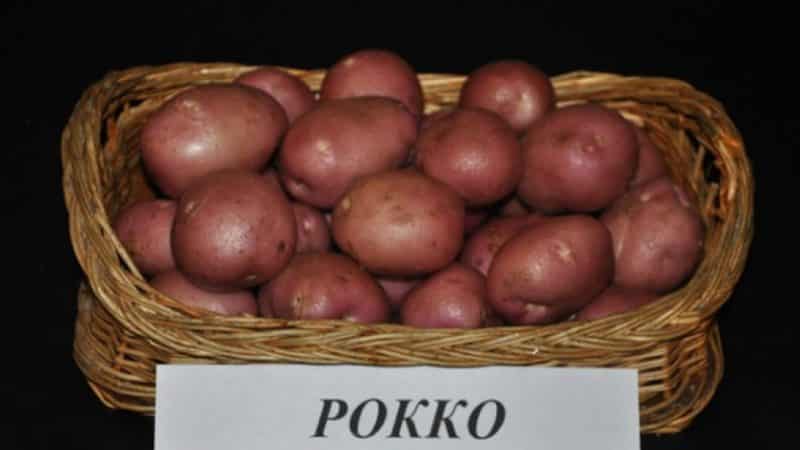
Roko differs from other varieties in appearance. It is characterized by medium-tall, erect bushes with an abundance of shoots. The flowers are purple, the leaves are small with wavy edges. Often there is no flowering.
Another difference between Roko potatoes and other varieties is their high starch content (up to 16%) and unique taste, thanks to which they are loved by housewives all over the world. Tubers are boiled, fried, baked, used to make chips and French fries.
Reference. During the cooking process, potatoes do not tend to boil, lose shape or change color. The pulp remains white after heat treatment.
Comparison table between Rocco and other potato varieties.
| Name | Starchy content, % | Weight of potatoes, g | Yield indicator, c/ha |
| Rocko | 13-16 | 125 | 400 |
| cornflower | 12-15 | 80-120 | 200-400 |
| Sineglazka | 15 | 70-130 | 500 |
| Breeze | 11-14 | 100-150 | 600 |
| Kubanka | 10-14 | 90-130 | 220 |
| Alvara | 12-14 | 90-100 | 300-440 |
Chemical composition, trace elements and vitamins
Roko is characterized by a rich chemical composition, due to which its consumption is beneficial for health.
Tubers contain a lot of:
- nicotinic acid;
- beta-carotene;
- retinol;
- thiamine;
- riboflavin;
- pantothenic acid;
- pyridoxine;
- folic acid;
- ascorbic acid;
- tocopherol;
- biotin.
Tubers are rich in beneficial microelements. They contain calcium, magnesium, sodium, potassium, phosphorus, sulfur, iron, zinc, selenium, manganese, iodine, copper, fluorine. The composition contains a number of organic and saturated fatty acids, as well as mono- and disaccharides.
Calorie content 100 g of potatoes is 77 kcal. In addition to water, this amount of product contains:
- proteins – 2 g;
- fat – 0.4 g;
- carbohydrates – 16.3 g;
- dietary fiber – 1.4 g.
Characteristics of tubers and yield
The Roko variety is a high-yielding variety. From one bush you get up to 12 tubers weighing about 125 g each. The yield indicator is 40 t/ha.
Potatoes have an oval shape. Their surface is smooth. The tubers are covered with a thin peel, ranging in color from light pink (or pale purple) to brown. The pulp is light with a creamy tint, tender.
Potatoes are distinguished by high quality and a marketability rate of 95%.
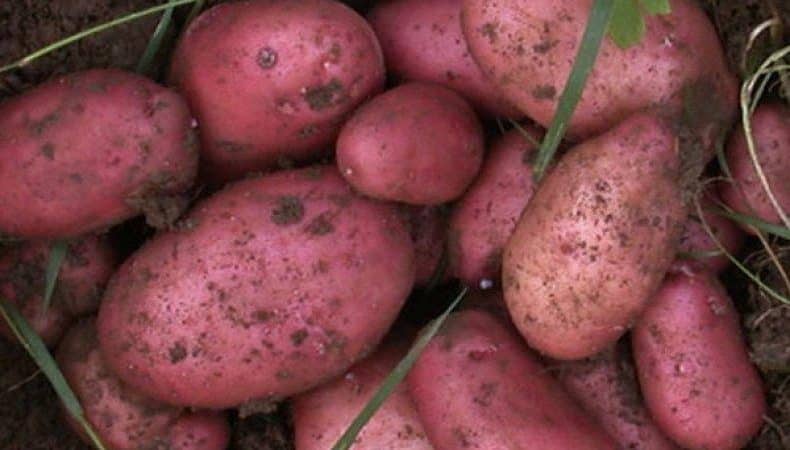
Regions for cultivation and planting dates
Roko is a variety with a medium ripening period. It takes 90-100 years from planting to harvest. Under unfavorable climatic conditions, the ripening period is longer - up to 150 days. That's why it is sometimes called late.
Potatoes of this variety grow in any weather, including drought and prolonged rainfall. Roko is suitable for growing in any region of the Russian Federation. It is unpretentious, not picky about soil and growing conditions.
Planting is recommended in May, when the soil warms up to +10⁰С. Roko is dropped off:
- in the first days - in the southern regions;
- in the middle of the month - in the central regions;
- at the end of May - in the northern part of the country.
Advantages and disadvantages
The Roko potato variety has many advantages, including:
- high productivity;
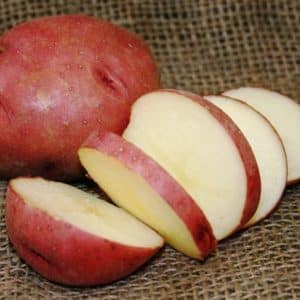
- marketable condition;
- excellent taste;
- immunity to virus Y, cancer, golden nematode;
- drought resistance;
- ease of care;
- good indicator of shelf life (in favorable conditions, tubers are stored for a long time without changing their appearance and taste characteristics).
The variety has virtually no disadvantages. One of the few is the susceptibility of plants to leaf blight.
Features of planting and growing
Roko is distinguished by its unpretentiousness in cultivation, carried out according to the rules of agricultural technology of this vegetable crop. Plants are content with minimal care.
Preparation
Vegetable crops of this variety are grown in a clean area. Roko does not grow in soil with a predominance of weeds. Weeds inhibit the tubers and prevent them from developing.
The soil for planting should be light, nutritious, and loosened. Poor soil is enriched with fertilizers; wood ash or humus is added to heavy soil.
Planting material is selected carefully: tubers without spots, growths, or signs of damage by insects are needed. They are germinated in a well-lit room. Tubers with sprouts no more than 1 cm in length are suitable for planting.
Planting scheme and technology
When planting planting material in open ground, adhere to the standard scheme. A distance of 35 cm is maintained between holes, and 60-70 cm between rows. The depth of the holes should not exceed 10 cm.
Features of cultivation
To obtain the highest possible yield, it is recommended to grow potatoes in floodplain, sod-podzolic, light loamy, sandy loam soil with a neutral acidity index.
It is advisable to grow potatoes in a well-lit and ventilated area. The plants are sun-loving, so they grow more slowly in the shade.
Nuances of care
Caring for plants primarily involves proper hilling. Thanks to it, you can increase productivity by 30%. Hilling helps saturate the soil with oxygen and get rid of weeds. Roko is spud twice:
- when the plants reach a height of 20 cm;
- on the eve of the flowering period.
Plants need loosening several times during the season. The soil is loosened between the rows after watering.
Another important procedure in caring for potato plantings is weeding. Without it you won’t get a good harvest. Weed the bushes using a hoe twice:
- 1 month after planting in open ground when the sprouts reach a height of 3-4 cm;
- when the bushes reach a height of 25-30 cm.
It is permissible to carry out weeding using a cultivator or walk-behind tractor.
Watering mode
Roko is drought tolerant, but needs proper watering. Water the plants three times during the season:
- when the tops appear;
- on the eve of flowering;
- before the flowers disappear.
Watering is carried out in the morning or evening hours in the absence of scorching sunlight. The first time the bush is watered with 2 liters of water, the second and third times they take 2 times more liquid. Water is first poured into barrels so that it can settle and warm up in the sun.
Important! Watering is contraindicated before sprouts form and immediately after flowering. There is a risk of late blight.
Watering is carried out in one of the following ways:
- Sprinkling - finely drip irrigation of the planting with water from a hose.
- Superficial. Suitable if groundwater is no higher than 4 cm.
- Drip irrigation. Watering is carried out through irrigation tubes connected to the roots of the plants.
Top dressing
To obtain maximum yield, fertilizers are needed. They are applied in the fall when digging after harvesting and clearing the area of weeds.
Apply feeding as: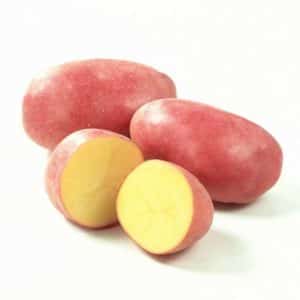
- an aqueous solution of bird droppings (1:10), which is used to water the soil between the rows;
- urea solution (1 tbsp per 10 liters of water) for watering bushes;
- mullein, which is used to water the rows.
Disease and pest control
Compliance with the rules of agricultural technology allows you to avoid scab damage.
However, Roko is susceptible to late blight. It attacks leaves in cold, rainy weather. Allows you to avoid problems preventive treatment with fungicides (“Revusom Top”, “Ordan”, “Poliram”) or antifungal agents (“Maxim”, “Fundazol”).
Treatment with Bazudin helps protect plants from wireworms. The Colorado potato beetle is collected from the bushes by hand.
Difficulties encountered during cultivation
Growing Roko potatoes does not pose any great difficulties. You get a bad harvest if you don’t adhere to the basic rules of agricultural technology. Typical mistakes:
- Use of organic matter in unreasonable periods. This mistake entails the leaching of nutrients and, as a result, a meager harvest.
- Using unrotted manure in the spring. Leads to the accumulation of weeds and pathogens of various plant diseases.
- Violation of the water regime. Leads to incomplete absorption of mineral fertilizers from the soil by the crop.
Harvest and storage
A good crop shelf life is ensured by compliance with the rules of collection and storage.
How and when to collect
The harvest is collected in a timely manner. Otherwise, there is a risk that the tubers will begin to deteriorate and rot. The timing of digging up potatoes is determined by the condition of the tops. It should turn yellow and dry out. A test dig is recommended to determine the degree of maturity of the potatoes.
Reference. After the tops die, the potatoes must be dug up before the rains. The optimal time for harvesting is from late August to mid-September.
On the eve of digging up the tubers, the tops are mowed and removed. This will prevent them from becoming infected. Potatoes removed from the ground are dried before being placed in storage boxes.
Storage features and keeping quality of the variety
Potatoes of the Roko variety are distinguished by a high percentage of keeping quality, which is 88-89%. It tolerates long-term transportation well. Tubers are stored in wooden containers or nylon nets in the cellar. Slots are pre-made in the boxes. Favorable conditions must be created in the room - darkness, lack of moisture and not too low a temperature.
Advice from experienced gardeners
Roko potatoes have been successfully grown in Russia for 17 years. To obtain a better and richer harvest, experienced gardeners recommend: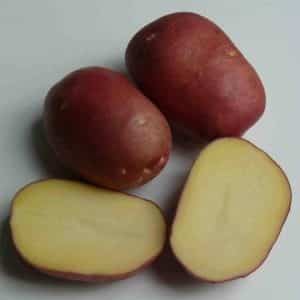
- Before planting the seed, pour a handful of wood ash into each hole. This measure helps to increase the starch content in the root crop and increases the crop yield.
- Plant Roko potatoes in an area that is as weed-free as possible and well-warmed by sunlight.
- Select for landing high-quality and healthy tubers without mechanical damage. Carry out pre-planting treatment of potatoes with Epin.
Reviews
Roko's potatoes have virtually no complaints. Reviews about it are positive.
Andrey, Novgorod: «This is a very good and productive variety. The first time I planted 1.5 kg and got about 18 kg of harvest. The next year I got even more potatoes. Under each Roko bush there is approximately 1 kg of tubers. I also really like the fact that the potatoes lie tightly in the bush, so you don’t have to dig up the whole garden.”
Anastasia, Nizhnekamsk: “It all started when I bought Roko potatoes at the market and boiled them. The whole family liked the taste. I decided to plant it in my garden. I purchased 6 kg of seed and planted it in early May. The tops grew tall, almost a meter high. There was no Colorado potato beetle on Roko, although it grazed nearby on other varieties. The harvest was good. The tubers formed close to the surface of the earth, although the potatoes were planted deep. Next time I’ll do a better job of hilling the bushes.”
Conclusion
Roko potatoes belong to high-yielding varieties. It is easy to care for and adapts to different weather conditions. By following all the rules for its cultivation, you can get a good harvest in almost any region of our country.